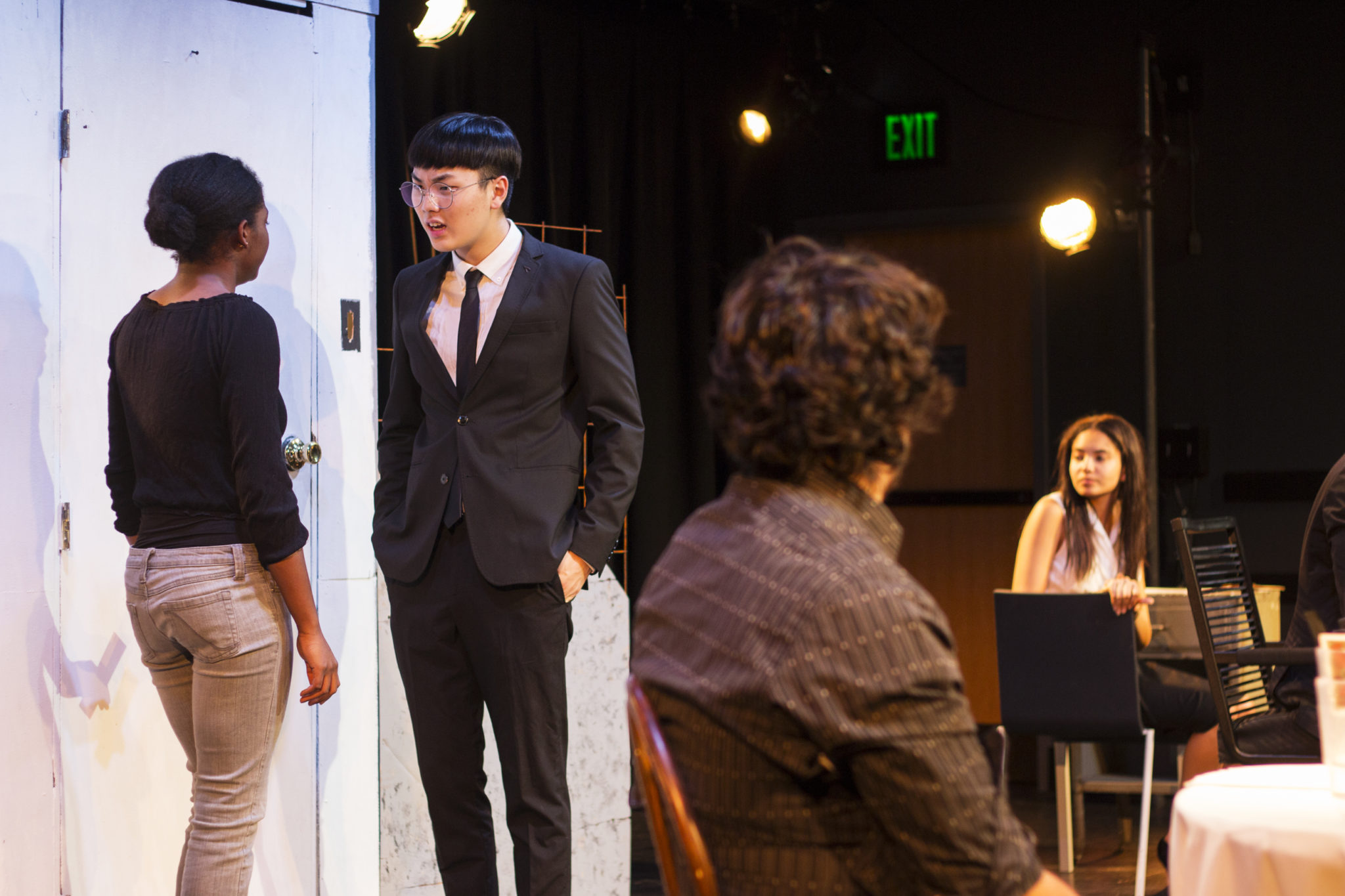
At first it’s only a single rhinoceros. Then two. Then three. Finally, some characters succumb to the epidemic of “rhinoceritis” — a disease that turns people into rhinoceroses. So goes “Rhinoceros,” directed by Alcindor Leadon ’17 and produced by Kit Lea Cheang ’19 and Declan Kunkel ’19, which opened last night.
Berenger, the protagonist played by Stephen Williams-Ortega ’20, starts the play as an apathetic, ordinary man. His friend Jean, played by Noah Stetson ’18, is cultured and attempts to persuade Berenger to follow his lead. Together they face the epidemic, and by the final scene they are both unrecognizable.
The French absurdist play, by Eugéne Ionesco, is an allegory for the rise of fascism in Europe in the 1940s. But the show has themes all too relevant to our own time. It’s an unsettling coincidence that the rhinoceroses “trumpet” throughout the show. In the end, the trumpeting takes over both the streets and the radio stations, which has chilling implications for our time.
Not unlike Democrats after Election Day, the characters are left wondering how the rhinoceroses have managed to take over their once-stable town.
The set design, by Hannah Kazis-Taylor ’19, smartly amplifies this theme. The walls behind the actors are crumbling, revealing the metal wiring holding the building together. The costumes, too, by Lola Hourihane ’20, seem uncertain. Though there’s some black and white, the majority of the actors wear shades of gray.
Despite the characters’ attempts to determine what sort of structure governs their society, they never quite figure it out. Why have the rhinoceroses come? How can they be prevented from gaining more power?
Dudard, played by Rohan Subramanian ’20, who is one of Berenger’s co-workers, suggests that staving off the epidemic is a matter of willpower.
“We are thinking people,” he proclaims.
Whether that thinking is reasonable or unreasonable goes unsaid. It’s not that the characters don’t attempt to be logical. It’s that they rarely succeed.
The Logician, played by Sabrina Clevenger ’18 in a role written for a man, uses his skills to try to determine whether the rhinoceros the townspeople see is African or Asiatic. But all he ends up proving, after a winding speech, is that the rhinoceros cannot be both African and Asiatic at once.
Some characters deal with the rhinoceros phenomenon by denying its existence. Botard, a higher-up at Berenger’s office, calls the rhinoceros sightings an example of “collective psychosis.” But after the existence of the rhinoceroses becomes undeniable he makes a Trump-esque flip-flop.
“I do not deny the rhinocerotic evidence. I never have,” he states.
The seriousness with which David Townley ’20, who plays Botard, delivers this line is extremely amusing. Another standout in the ensemble is Nurit Chinn ’20, who is hilarious in her portrayal of a housewife distraught over the loss of her cat.
While the first act is humorous and absurd, the second act is a dark, existential examination of the individual in relation to powerful social movements.
Finally, we see a truly intimate connection between two characters. Berenger and Daisy share a tender moment as they discuss the humanity of the rhinoceroses. Daisy, the love interest of seemingly everyone, is fittingly inhabited by the lovely Leslie Schneider ’20.
Williams-Ortega carries the emotional weight of the second act. His confusion and despair as he attempts to reconcile the presence of the rhinoceroses with his understanding of how society works is riveting. As is his final monologue, in which he deftly elicits sympathy from the audience.
Stetson deserves commendation as well for his time spent writhing on the ground in faux agony dressed in only his underwear. Arguably, it is Jean’s crisis that prompts Berenger’s, so Stetson has the large responsibility of setting the level of intensity for the second act, which he does with enormous commitment and energy.
One of the most memorable moments of the show is when the logician explains to a gentleman, played by Daniel Lee ’20, how to draw the logical conclusion that Socrates must be a cat using a syllogism, a three-part logic device.
“All cats die. Socrates is dead. So Socrates must be a cat,” he explains.
The syllogism is a perfect metaphor for the show (though hopefully not for our time). There’s certainly an underlying logic. And it all almost makes sense. At the same time, though, it confounds just enough to make you wonder.







